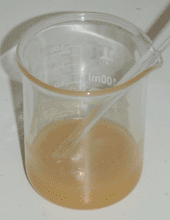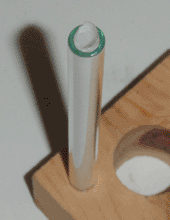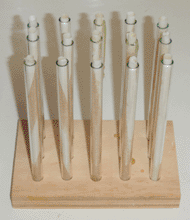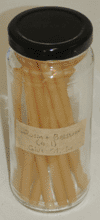




Molten pine rosin is extremely sticky, and this property has led to its use since prehistory as a general-purpose adhesive. It has an inherent limitation, however, in that it it becomes weak and brittle as it solidifies. To overcome this, a plasticizer must be added, and historically the most common material for this application was beeswax. Initially I was simply curious about the properties of this combination of materials, but early in my experimentation I discovered that it also had a practical application within my workshop.
I began by melting 20 grams of pine rosin in a small beaker, then observing its behavior as it cooled. As expected, it became glassy and brittle, readily chipping and turning into dust. I then added small amounts of beeswax at a time, repeating the melting and cooling process for each addition. At approximately 5% beeswax by weight, the rosin began to sound more like plastic than glass when tapped, but was otherwise unchanged. At 10%, the surface of the room-temperature rosin could be dented slightly, but the bulk of the material was still brittle. Finally, at 20%, the rosin had become significantly plastic, and would only fracture if struck sharply. At this point, I considered it adequate as a general-purpose glue. I used a glass stirring rod to drip it onto various surfaces, and it was able to bond wood, metal, and paper without issue.
Throughout this experimentation, I noticed that the behavior and viscosity of the rosin-beeswax mixture were nearly identical to that of ordinary hot glue. Furthermore, I found that it reached optimal fluidity at approximately 120°C, which is the exact operating temperature of common low-temperature glue guns. Out of curiosity, I purchased a small glue gun of this type for $3, and made a glue stick mold out of glass tubing and scrap wood, lining the glass with rolled parchment paper to prevent sticking. Making a glue stick this way was straightforward, although I did find it beneficial to refrigerate the mold after pouring to make the stick easier to remove.
Upon testing, the rosin glue behaved nearly identically to commercial glue sticks, with two slight differences. First, the glue had no tendency to form endless strings, and second, it was stiff rather than rubbery when cool. Both of these properties are attributable to the lack of polymer content, and I consider both to be improvements. The adhesion is equivalent to commercial glue, and the smell is significantly improved. In fact, the glue performed so well that I immediately made a larger set of molds and cast fifteen more glue sticks, just to have on hand. It is entirely possible that I will never use ordinary glue sticks again.
Although this glue is useful as-is, like many products based on natural materials, it is also fairly open-ended. Various additives can change the nature of the glue, making it more suitable for specific applications. Historically, two examples of this are cutler's resin (made by adding chalk or sawdust) and sealing wax (made by adding a dry pigment). Furthermore, the melting point of the glue can be modified by the type of resin and wax used, and the stiffness of the glue can be modified by the ratio of resin to wax. However, rather than exploring these options exhaustively, I intend to make them as needed for future projects.
Unfortunately, this glue is not stable in the long term, and within a year it loses most of its plasticity and becomes more difficult to melt. This happens even when kept in a sealed container, so it is likely due to a reaction between the beeswax and the rosin. This could possibly be resolved by using an excess of beeswax, or by using a less reactive resin such as shellac. In any case, this should be considered a strictly temporary adhesive unless the two objects being joined are totally rigid, and even then it should not be considered structural.